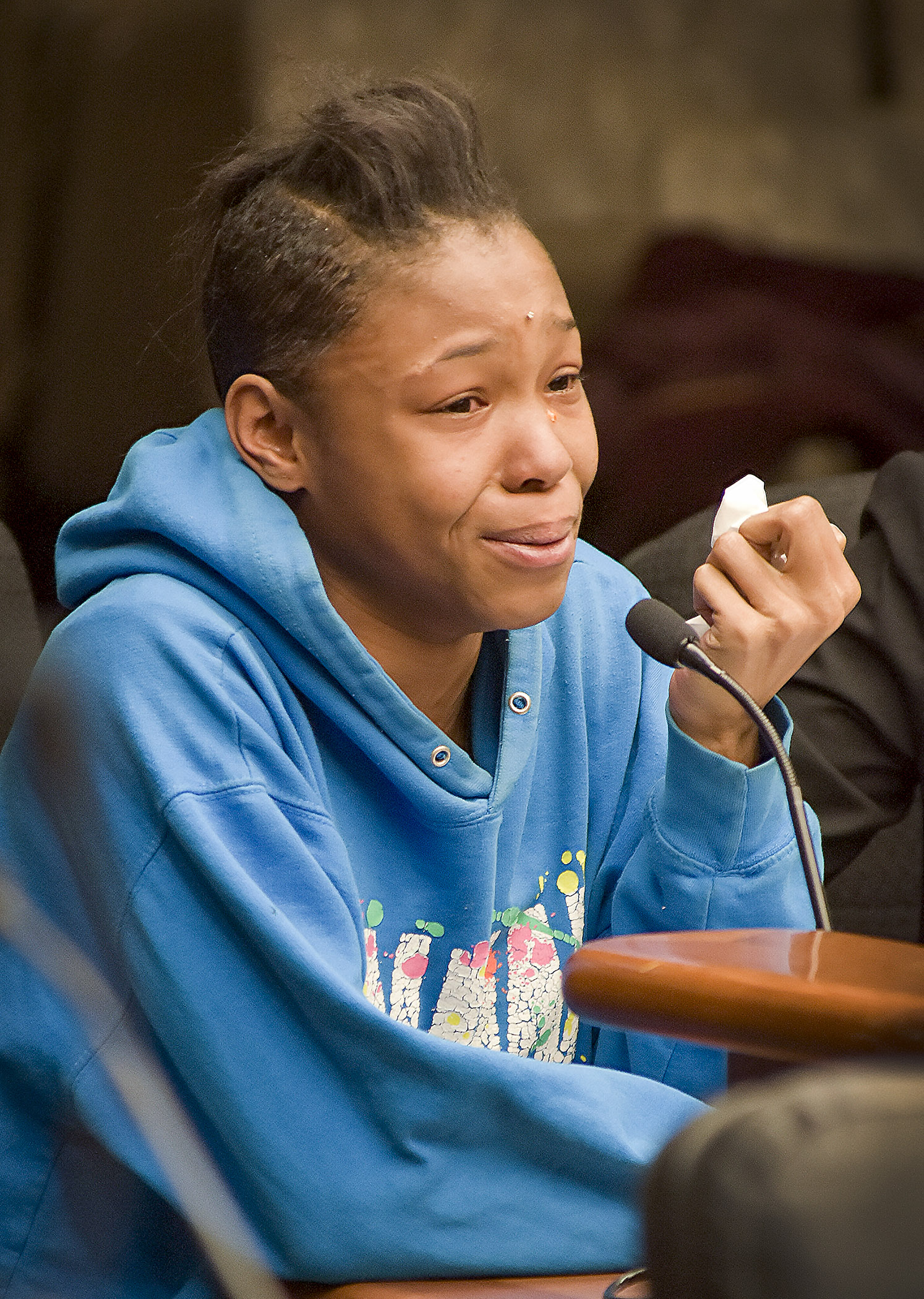Services for exploited youth to be expanded in proposed bill
When Symmieonna Williams was sex trafficked, she was a minor with nowhere to go.
“We knew that we needed help, but we didn’t have the right kind of help” she said. “We didn’t have anything … and all they did was throw us in jail and that’s not going to help anything.”
 Symmieonna Williams, youth leader at The Link, gives emotional testimony to the House Health and Human Services Reform Committee Feb. 7 during a discussion on two sex trafficking prevention bills. Photo by Andrew VonBank
Symmieonna Williams, youth leader at The Link, gives emotional testimony to the House Health and Human Services Reform Committee Feb. 7 during a discussion on two sex trafficking prevention bills. Photo by Andrew VonBankThat started to change in 2011, when Minnesota became the fifth state in the country to pass a “Safe Harbor” law, preventing sexually trafficked children under 18 years old from being charged for their own exploitation.
The law went into effect in 2014, once resources were in place to give them an option other than returning to the streets or facing juvenile detention, Jeff Bauer, president of public affairs for The Family Partnership told the House Health and Human Services Reform Committee Tuesday
But those resources are not sufficient and the change needs to extend beyond minors to include victimized adults, said Rep. Tim Miller (R-Prinsburg), who sponsors two bills that would address the issue.
HF714 would allocate $2.3 million over the next biennium to establish more dedicated shelter beds, conduct training, improve services and increase their coverage. Its companion is SF531, sponsored by Senate Majority Leader Paul Gazelka (R-Nisswa).
Miller’s other bill, HF713, is less direct and would allocate $75,000 in Fiscal Year 2018 to develop a strategic plan to address how victimized adults should be treated. Its companion is SF663, sponsored by Sen. Jerry Relph (R-St. Cloud).
The committee approved both bills and referred them to the House Public Safety and Security Policy and Finance Committee. Both bills’ companions await action by the Senate Human Services Reform Finance and Policy Committee.
'Our work is not done'
Since Safe Harbor was signed into law, Minnesota has invested $11 million to address the sex trafficking of minor victims, Bauer said.
This has led to an increase in dedicated shelter beds from two to 40 since 2011, comprehensive support services, and more than 2,000 law enforcement personnel trained to identify trafficked youth and investigate their cases. But the need is still significant, Bauer said.
One of the programs to benefit, The Link’s Passageways Shelter and Housing Program, was developed with the assistance of trafficking survivors, including Williams. It is their answer to the question, “If you guys had a place to call home, what would it be like?” Williams said.
“Everything that we didn’t have is what we put into Passageways … We’re helping these girls,” she said.
Last year, the organization provided emergency shelter and housing to 67 trafficked youth between 13 and 17 years old.
It also offers a housing program for trafficking victims between 16 and 23 years old.
But on most mornings, the program is at full capacity with a waiting list. On the morning of the hearing, seven victims were waiting for a place in the emergency shelter, executive director Beth Holger-Ambrose said.
“Our work is not done,” Holger-Ambrose said. “People oftentimes ask us to expand or build capacity to serve more youth, and all of that takes, obviously, additional resources.”
Many other trafficking victims are adults and their exploitation can’t necessarily be addressed effectively through the same strategies used to address the trafficking of minors, Bauer said.
“If you’ve been exploited since you were 12, 13, 14 years old, you cannot wake up on your 18th birthday and suddenly have a choice, as an adult, to get out of that life of exploitation,” Bauer said. “What are we doing about adults that are going through the same exploitation, the same trafficking, and are not criminals?”
HF713 calls for a strategic planning process that would mirror the one used to develop Safe Harbor and involve victims, advocates, law enforcement, and service providers, Miller said.
“We have a lot of good pieces, but they need to be put together through this strategic plan,” Miller said.
Related Articles
Search Session Daily
Advanced Search OptionsPriority Dailies
Ways and Means Committee OKs proposed $512 million supplemental budget on party-line vote
By Mike Cook Meeting more needs or fiscal irresponsibility is one way to sum up the differences among the two parties on a supplemental spending package a year after a $72 billion state budg...
Meeting more needs or fiscal irresponsibility is one way to sum up the differences among the two parties on a supplemental spending package a year after a $72 billion state budg...
Minnesota’s projected budget surplus balloons to $3.7 billion, but fiscal pressure still looms
By Rob Hubbard Just as Minnesota has experienced a warmer winter than usual, so has the state’s budget outlook warmed over the past few months.
On Thursday, Minnesota Management and Budget...
Just as Minnesota has experienced a warmer winter than usual, so has the state’s budget outlook warmed over the past few months.
On Thursday, Minnesota Management and Budget...